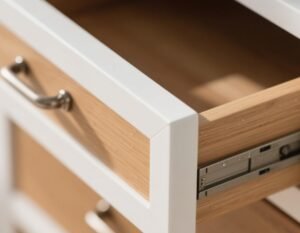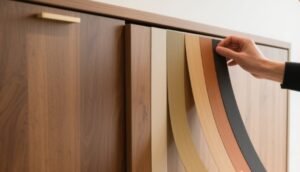High humidity ruins furniture faster than we expect. Swelling, peeling, and mold problems often start at the edge. That’s where smart edge banding choices matter most.
If you’re designing or building furniture for humid environments, you need edge banding that resists moisture and stays in place over time. Let me explain how to choose the right one.

Furniture in humid places needs special treatment. The right edge banding can prevent long-term damage and help your furniture look new for years. Let’s break it down.
Why High Humidity Poses a Challenge for Edge Banding Applications?
Humidity weakens furniture from the inside. It swells panels, loosens glue, and destroys edges. The damage often starts where panels are most exposed: the edges.
Moisture causes edge banding to loosen, warp, or fall off completely. In extreme cases, mold forms under the edge strips. So if we ignore this, the whole piece gets ruined.

Why humidity attacks the edges first
Edges are vulnerable because they’re where different materials meet. The joint between the panel core and the edge strip is especially sensitive to heat and water.
- Swelling core: MDF or particleboard absorbs water fast. If the edge banding doesn’t seal it well, swelling happens in days.
- Glue failure: Standard hot melt adhesives don’t hold in damp conditions. When humidity rises, they get soft and lose grip.
- Material mismatch: Some plastics expand or contract faster than wood, leading to detachment or cracks.
| Humidity Effect | Result at Edges |
|---|---|
| Swelling | Edge bulging and cracking |
| Glue softening | Peeling or falling strips |
| Mold growth | Health hazard and odor |
Understanding this helps us find better materials and construction methods that hold up even in high-humidity spaces.
Key Features to Look for in Moisture-Resistant Edge Banding?
Not all edge banding performs well in humidity. To avoid failure, I look for specific traits that prevent water from entering and keep the bond strong.
Moisture-resistant edge banding must have strong sealing, durable adhesives, and stable materials that don’t change shape in humidity.

What makes edge banding resist humidity?
There are a few features I always check before picking an edge banding product for wet spaces.
1. Waterproof core sealing
Good edge banding must fully cover the panel edge, creating a barrier. Rounded profiles or thicker strips help prevent water entry.
2. High-performance adhesives
Standard hot melt glue won’t hold up. I use PUR (polyurethane reactive) adhesives—they create a chemical bond and resist both heat and moisture.
3. Material stability
The edge strip material must not warp or stretch. ABS, PP, and PVC with anti-humidity treatments stay flat and secure even in changing temperatures.
| Feature | Importance in Humid Conditions |
|---|---|
| PUR Adhesive | Excellent water and heat resistance |
| Thick profile strips | Better sealing and durability |
| Sealed corners | Reduces mold risk |
| Non-porous surface | Prevents water absorption |
When these features come together, the result is a long-lasting, professional edge that works in kitchens, bathrooms, or anywhere moisture is a problem.
Best Edge Banding Materials for High-Humidity Environments?
In my experience, not every material works the same way when humidity goes up. Some absorb water, others warp, and a few stay perfect.
The best materials for high humidity are ABS, PP, and upgraded PVC. They resist water, stay flat, and bond well with PUR adhesives.

A closer look at material options
When choosing the right edge banding, I look beyond color and price. I check how the material behaves when it’s hot, wet, or both.
ABS (Acrylonitrile Butadiene Styrene)
ABS is strong and flexible. It doesn’t get brittle with age or heat. It resists chemicals and moisture well, making it ideal for bathrooms and kitchens.
PP (Polypropylene)
PP is lightweight and waterproof. It’s great for projects in coastal or tropical areas. But it’s slightly harder to glue, so it needs the right adhesive.
Upgraded PVC
Not all PVC is equal. Standard PVC might absorb water over time, but newer versions have protective layers that help them hold up well in wet spaces.
| Material | Water Resistance | Adhesive Compatibility | Flexibility | Typical Use Cases |
|---|---|---|---|---|
| ABS | High | Excellent with PUR | Medium | Kitchen, bathroom cabinets |
| PP | Excellent | Needs special glue | High | Coastal furniture |
| PVC+ | Moderate–High | Good | High | General household furniture |
Material choice alone isn’t enough—you must also consider how it’s applied. Still, choosing the right base gives you a big head start.
Real-World Applications: Edge Banding for Bathrooms, Kitchens, and Coastal Areas?
Humidity isn’t just a weather problem—it’s built into the use of some rooms. Wet zones like kitchens and bathrooms demand edge banding that lasts.
I’ve used moisture-resistant edge banding in many projects, including bathrooms, laundry rooms, kitchens, and even beachside apartments. Here’s what I learned.

Where humidity hits hardest
In daily life, these are the most common places where high humidity damages furniture:
Bathroom vanities
Steam from showers raises humidity fast. Unsealed edges warp and peel in months. I always use PUR glue and ABS strips here.
Kitchen cabinets
Cooking and cleaning generate constant moisture. Especially under sinks and around dishwashers, where leaks are common, extra sealing is essential.
Coastal homes
Salt in the air accelerates corrosion and breakdown. I use PP edge banding in coastal projects because it handles salt and moisture better than others.
| Application Area | Edge Banding Recommendation |
|---|---|
| Bathroom Vanity | ABS + PUR Adhesive |
| Kitchen Sink Area | Upgraded PVC or ABS + Sealing Coat |
| Coastal Furniture | PP + Specialized Primer |
| Laundry Room Cabinets | PVC with waterproof treatment |
In these spaces, cutting corners means disaster. Good edge banding pays off in the long run with fewer replacements and happier clients.
Tips for Long-Lasting Edge Banding Performance in Humid Conditions?
Even the best materials fail without the right process. Good edge banding requires smart installation and smart maintenance—especially in humid conditions.
To get lasting results, I always follow five simple steps during installation and aftercare.

Installation and maintenance tips that make the difference
1. Use PUR adhesive whenever possible
It reacts with moisture to form a permanent bond. That’s exactly what we need in damp rooms.
2. Seal all edges, including corners
Don’t skip small sections. I apply extra pressure at corners and joints to ensure full contact.
3. Avoid exposing freshly bonded pieces to steam
Curing time matters. I wait at least 24 hours before installing in bathrooms or kitchens.
4. Clean the surface before application
Even slight dust or grease weakens the bond. A simple wipe-down with alcohol improves grip.
5. Educate your clients
I always tell my customers: Don’t leave water sitting on edges. Even waterproof materials need basic care.
| Tip | Why It Matters |
|---|---|
| PUR adhesive | Strongest, most water-resistant bond |
| Full edge sealing | Blocks water entry at weak points |
| Curing time | Prevents early failure due to steam |
| Surface cleaning | Ensures maximum adhesive performance |
| Client education | Keeps furniture lasting longer |
Even small improvements in process can double the life of edge banding in humid spaces. I’ve seen it firsthand on many projects.
Conclusion
Humidity can’t be avoided—but it can be managed. The right edge banding materials and methods protect your furniture and your reputation.




